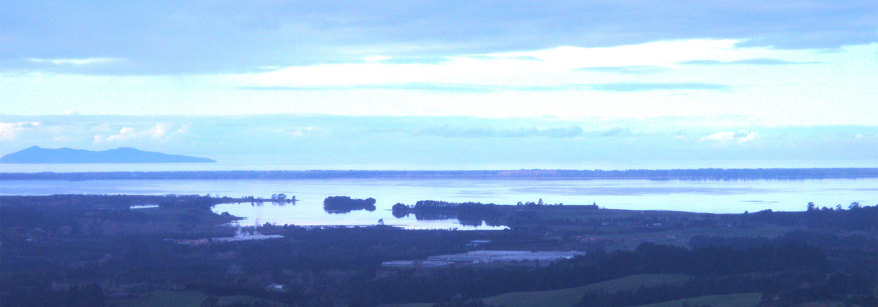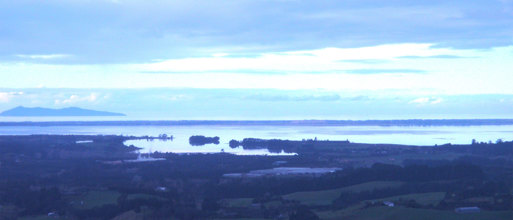Based on previous long term monitoring in the Te Mania Stream (Hamill et al., 2020) and in the Rereatukahia Estuary (Park, 2015, 2016; Crawshaw, in prep.; Lawton & Conroy, 2019), the key water quality issues identified in the Te Mania catchment are elevated bacteria (E.coli), Total Suspended Solids (TSS) and Ammoniacal-Nitrogen.
Water monitoring summary
- Water quality monitoring has occurred regularly in Te Mania Stream since 1990.
- Environmental issues in the Te Mania catchment are elevated coli bacteria, total suspended solids (sediment) and Ammoniacal Nitrogen.
- Te Mania Stream flows into the Rereatukahia Estuary which is part of Tauranga Harbour.
- Rereatukahia Estuary has high mud content from the sediment in Te Mania Stream.
There have been improvements in land management practices throughout the catchment, including improved stock management, riparian retirement and fencing, which are likely to have contributed to improving trends for Ammoniacal-N and turbidity at the Te Mania SH2 site, however these contaminants are still significant water quality issues in this catchment. The high mud content in the Rereatukahia Estuary between 2014 and 2019 (Crawshaw, in prep.) indicates that sedimentation is continuing to have a negative impact on the receiving environment.
E.Coli and Faecal Source Tracking
Fourteen E. coli samples from a 2019/2020 Te Mania catchment investigation were tested for Faecal Source Tracking (FST). Nine samples were taken from a rainfall event to track the source of faecal bacteria from overland flow conditions, and five samples were taken in low flow conditions. The results showed that in both overland and low flow conditions, the dominant sources of E. coli bacteria in the Te Mania catchment were ruminant and avian animals. There was no human or dog faecal bacteria detected in the samples tested.
Ecological monitoring summary
The ecological state of the Te Mania Stream at Chard Road between 2014 and 2017 was considered ‘very good’ based on a ranking system developed by Carter et al. (2018). This ranking system classifies ecological health on a scale of Poor to Very Good based on the Macroinvertebrate Community Index (MCI), the number of Ephemeroptera (mayflies), Plecoptera (stoneflies) and Trichoptera (caddisflies) (EPT) and the Bay of Plenty Index of Biotic Integrity (BOP_IBI). No clear trends in ecological condition have been determined for this site by Carter et al. (2018), indicating that the invertebrate community at this site is in a relatively stable state.
Historical freshwater fish monitoring at three sites in the Te Mania catchment in 1973 and 1999 identified longfin eel, torrentfish, banded kōkopu, inanga, common and redfin bullies, smelt and unidentified eels (A. Suren, personal communication, June 3 2020). The most recent freshwater fish monitoring in 2015 showed an increase in abundance of species and species richness (including the addition of shortfin eel to the species found in the catchment), increasing the Fish IBI from “moderate” in the older research to “good”.
Receiving environment monitoring - Rereatukahia Estuary
Rereatukahia Estuary is the receiving environment of the Te Mania catchment. There are six NERMN estuarine sediment monitoring sites in Rereatukahia Estuary. Four have been monitored annually since 2014, and two monitored annually since 2019. Rereatukahia Estuary has an active estuary care group (Uretara Estuary Managers) which has developed an estuarine monitoring programme with support from BOPRC. This is linked with the NERMN (Natural Environment Regional Monitoring Network) monitoring conducted by BOPRC, with the addition of epifauna, macrofauna and bird counts conducted at each site.
Volunteer-led estuary monitoring by the Uretara Estuary Managers care group over recent years indicates poor species diversity and abundance of benthic fauna in Rereatukahia Estuary (Donald, 2020). Additionally, anecdotal observations of marine fish and shellfish are limited to three shellfish species, mud crabs and common marine fish species such as flounder, kahawai, grey mullet, yellowtail kingfish, snapper, trevally, sharks, stingrays, orca and longfin and shortfin eels (Donald, 2020). Gathering kaimoana is not common in the Rereatukahia Estuary due to low abundance of shellfish (L. Donald, personal communication, July 9 2020).
Seagrass used to cover 31 km2 within the estuary in 1959, however this has decreased to less than 0.2 km2 in 2011 (Park, 2016). Mangrove coverage has increased from 13 km2 in 2003 to 24 km2 in 2011 (Park, 2015). Rereatukahia Estuary has low coverage of nuisance macroalgae species, with Ulva spp. and Gracilaria chilensis having coverage ranging from 0% – 0.7% between 2015 and 2019. All sediment sites at Rereatukahia Estuary are either in the fair or poor banding for mud content, indicating poor sediment quality (Crawshaw, in prep.). Heavy metals are generally graded “very good”, with the exception of elevated mercury concentrations at one site. Sedimentation rates range from very good (<1 mm/year) to fair (>2 to <5 mm/year) (Lawton & Conroy, 2019).


